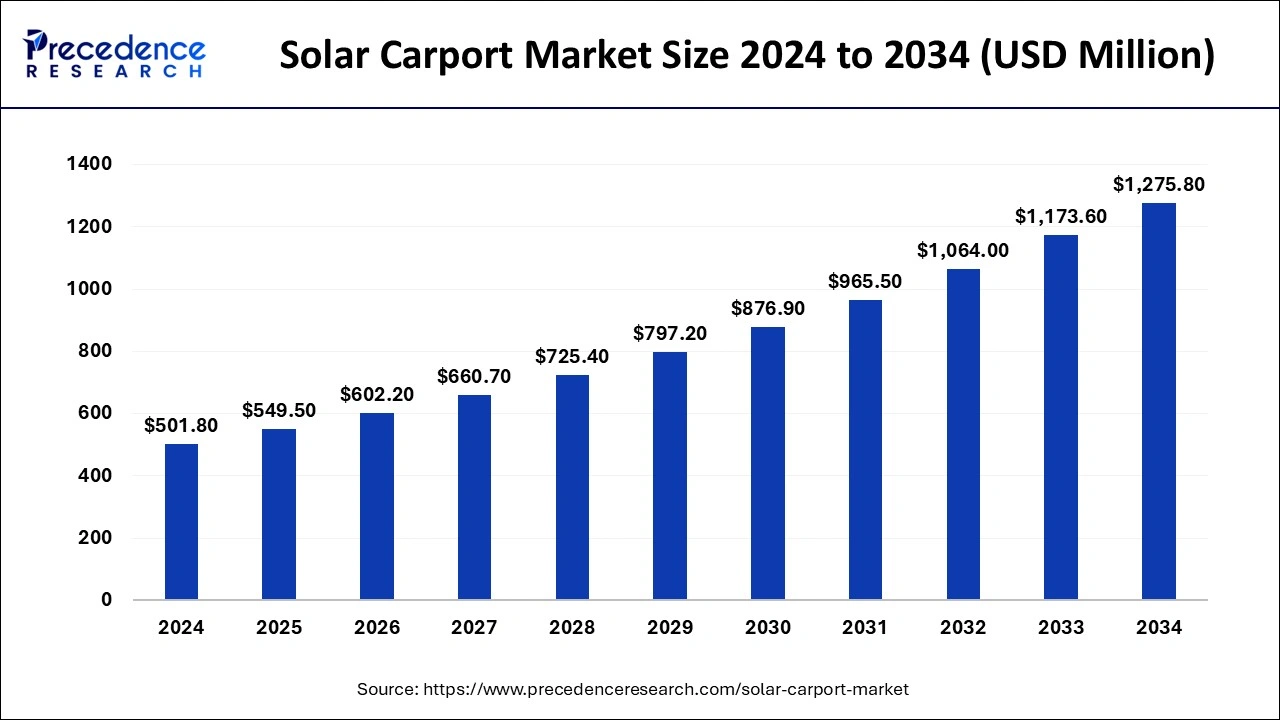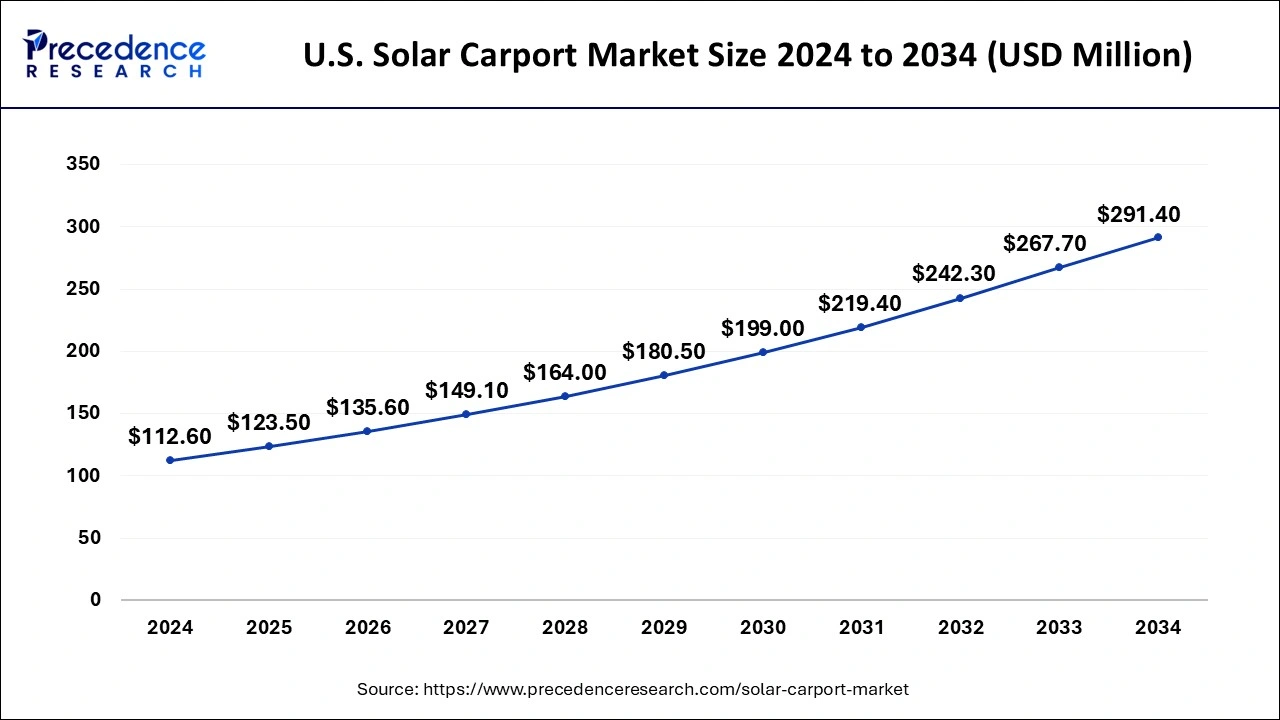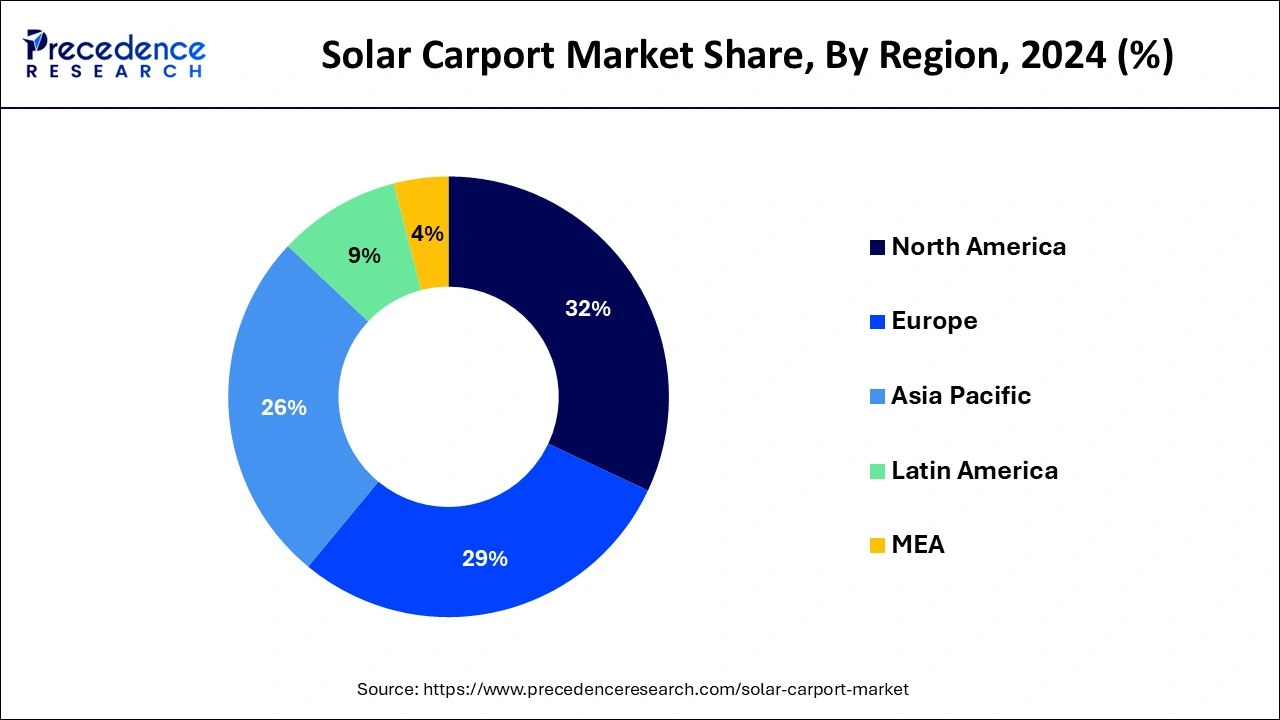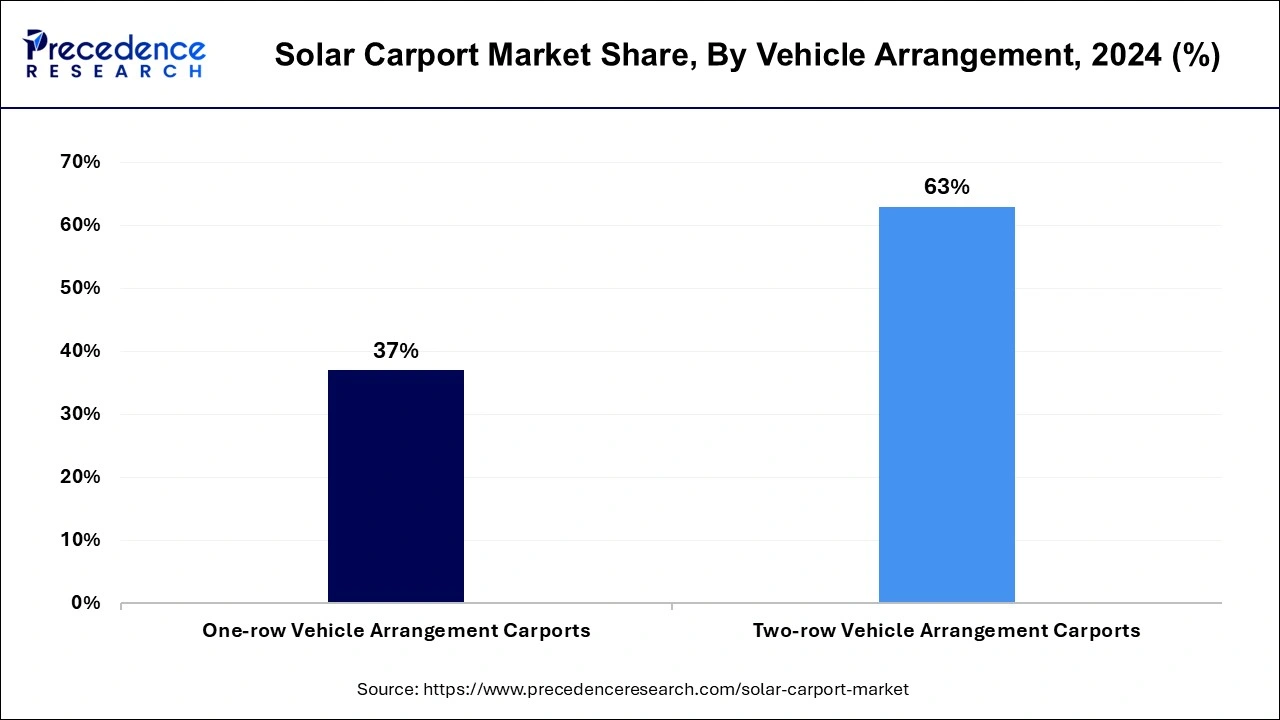October 2024
The global solar carport market size is calculated at USD 549.50 million in 2025 and is forecasted to reach around USD 1,275.80 million by 2034, accelerating at a CAGR of 9.78% from 2025 to 2034. The North America market size surpassed USD 160.58 million in 2024 and is expanding at a CAGR of 9.80% during the forecast period. The market sizing and forecasts are revenue-based (USD Million/Billion), with 2024 as the base year.
The global solar carport market size was estimated at USD 501.80 million in 2024 and is predicted to increase from USD 549.50 million in 2025 to approximately USD 1,275.80 million by 2034, expanding at a CAGR of 9.78% from 2025 to 2034.

The U.S. solar carport market size was exhibited at USD 112.60 million in 2024 and is projected to be worth around USD 291.40 million by 2034, growing at a CAGR of 9.98% from 2025 to 2034.

In 2024, North America held a share of 32% in the solar carport market due to a confluence of factors. The region's robust commitment to renewable energy, supportive government policies, and substantial investments in sustainable initiatives contribute to its major market share. Additionally, a heightened awareness of environmental issues and a growing inclination towards clean energy solutions propel the adoption of solar carports. The presence of key industry players, technological advancements, and the integration of solar carports with electric vehicle infrastructure further solidify North America's leading position in this burgeoning market.

Asia-Pacific is primed for significant growth in the solar carport market due to a combination of factors. Rapid urbanization, increasing energy demand, and a strong focus on sustainability are driving the adoption of solar technologies. Supportive government policies, incentives, and a growing awareness of environmental issues further propel the solar carport market. As the region embraces clean energy solutions, the demand for solar carports is expected to surge, making Asia-Pacific a key player in the global shift towards renewable energy.
Meanwhile, Europe is witnessing significant growth in the solar carport market due to a convergence of factors. Increasing environmental consciousness, supportive government policies, and a push towards sustainable practices are driving the adoption of solar carports. Government incentives and favorable regulations encourage businesses and individuals to invest in renewable energy solutions. Additionally, advancements in solar technology, coupled with a growing interest in electric vehicles, create a synergistic environment for the expansion of solar carports across Europe, contributing to the region's notable growth in this market.
A solar carport is a structure designed to provide shelter for vehicles while also harnessing solar energy to generate electricity. Essentially, it combines the functionality of a traditional carport with solar panels installed on the roof. The top surface of the carport is fitted with solar photovoltaic panels, which capture sunlight and convert it into electrical power. This renewable energy can be used to charge electric vehicles, power nearby buildings, or feed back into the grid. Solar carports not only offer protection for vehicles from the elements but also contribute to sustainable energy practices by utilizing clean and environmentally friendly solar power. They are increasingly popular as part of efforts to promote green energy solutions and reduce dependence on conventional sources of electricity.
Solar Carport Market Data and Statistics
| Report Coverage | Details |
| Growth Rate from 2025 to 2034 | CAGR of 9.78% |
| Market Size in 2025 | USD 549.50 Million |
| Market Size by 2034 | USD 1,275.80 Million |
| Base Year | 2024 |
| Forecast Period | 2025 to 2034 |
| Segments Covered | Application, Type, and Vehicle Arrangement |
| Regions Covered | North America, Europe, Asia-Pacific, Latin America, and Middle East & Africa |
Driver
Reduced solar panel costs
The drop in solar panel costs is like a booster rocket for the solar carport market, propelling it to new heights. As solar technology gets more affordable, it is like opening the door for everyone to join the renewable energy party. Imagine if the cost of your favorite gadget suddenly became way cheaper – you would be more likely to grab it, right? Well, the same goes for solar carports. With solar panels becoming more pocket-friendly, setting up a solar carport becomes a feasible and attractive option for businesses and individuals alike. This cost reduction is like the green light for widespread adoption.
It is not just about being environmentally conscious; it is also about making economic sense. People are more inclined to invest in solar carports when the upfront costs become friendlier, ultimately driving a surge in demand, and bringing us a step closer to a greener and more sustainable future.
Land use and space limitations
The constraint of land use and space limitations poses a real challenge to the widespread adoption of solar carports. Picture your favorite parking lot – it's probably not endless. Solar carports require a good amount of space, and in bustling urban areas where real estate is at a premium, finding enough room for these structures becomes like fitting a square peg into a round hole. Limited space availability makes it difficult for businesses and individuals to embrace solar carports, especially in areas where every inch counts. Moreover, the struggle with space constraints impacts not only the feasibility but also the scalability of solar carports.
The desire to harness solar power for clean energy meets a roadblock when there's simply not enough room to set up these structures. As we navigate the challenge of space limitations, it becomes crucial for stakeholders to explore innovative solutions and design approaches that maximize the benefits of solar carports without compromising on precious space.
Modular and scalable designs
The introduction of modular and scalable designs is like unlocking a world of opportunities for the solar carport market. Imagine building blocks that fit together seamlessly, allowing solar carports to adapt to various locations and accommodate diverse spatial constraints. This flexibility not only simplifies the deployment process but also ensures that solar carports can be tailored to the unique needs of different businesses, institutions, and individuals. Whether it's a small parking area or a large commercial space, modular designs make it possible to scale up or down, making solar carports accessible and practical for a wide range of users.
Moreover, the scalability of these designs fosters easier integration into existing infrastructure and new construction projects. It's like having a solar solution that can grow with the evolving energy needs of a community or business. This adaptability not only enhances the appeal of solar carports but also contributes to the overall feasibility and attractiveness of embracing renewable energy solutions, creating a pathway for the market to expand and flourish.
The commercial segment held the highest market share of 76% based on the application. In the solar carport market, the commercial segment refers to the deployment of solar carports in spaces primarily used for business activities. Commercial solar carports are commonly installed in parking lots of offices, shopping centers, and industrial complexes. A notable trend in this segment involves businesses increasingly adopting solar carports to not only provide shaded parking for employees and customers but also to generate clean energy, reducing operational costs and showcasing a commitment to sustainable practices. This dual functionality aligns with the growing demand for eco-friendly solutions in the commercial sector.
The residential segment is anticipated to witness rapid growth at a significant CAGR of 11.4% during the projected period. In the solar carport market's residential segment, the focus is on bringing clean energy solutions to individual homes. This involves installing solar carports in residential driveways or parking spaces, providing households with renewable energy while sheltering their vehicles. The trend in this segment reflects a growing interest among homeowners in adopting sustainable practices. With increasing awareness and incentives, residential solar carports are becoming a popular choice, allowing individuals to harness solar power for their homes while contributing to a greener and more environmentally conscious lifestyle.
The T-shape solar carports segment has held a 42% market share in 2024. T-shape solar carports represent a specific design in the solar carport market where the structure resembles the letter "T." This configuration typically features a central column with solar panels extending horizontally on both sides, creating a T-shaped canopy. This design not only provides effective shading for parked vehicles but also optimizes solar panel exposure to sunlight. The T-shape solar carport segment is gaining traction due to its space-efficient layout and potential for higher energy generation, contributing to the overall trend of innovative and functional solar carport designs.
The semi-cantilever solar carports segment is anticipated to witness rapid growth over the projected period. Semi-cantilever solar carports represent a type of solar carport structure where the solar panels are mounted on one end of the supporting structure, creating a partial cantilever design. This configuration allows for increased flexibility in positioning and space utilization. In the solar carport market, the semi-cantilever segment is witnessing a growing trend due to its efficient use of space and adaptable design. Businesses and institutions are increasingly adopting semi-cantilever solar carports as they offer a balance between structural stability and the ability to cover a significant parking area while optimizing solar panel exposure for enhanced energy generation.
The two-row vehicle arrangement carports segment has held 63% market share in 2024. In the solar carport market, the two-row segment refers to a configuration where solar panels are arranged in two rows to maximize energy capture. This design is popular for optimizing space while providing efficient energy production. A trend in the two-row segment involves advancements in panel tilt and spacing to enhance sunlight exposure, improving overall performance. This trend aligns with a focus on maximizing energy efficiency and adapting solar carport designs to diverse locations, making them more versatile and appealing to a broad range of users.

The one-row vehicle arrangement carports segment is anticipated to witness rapid growth over the projected period. In the solar carport market's one-row segment, arrangements involve placing solar panels in a single row, optimizing space efficiency and ease of installation. This design trend is gaining traction as it provides a balance between energy production and simplicity. The one-row arrangement minimizes shading effects among panels, maximizing sunlight exposure and energy generation. This trend aligns with a practical approach, making solar carports more accessible and appealing for various applications, from residential settings to commercial parking lots.
By Application
By Type
By Vehicle Arrangement
By Geography
For inquiries regarding discounts, bulk purchases, or customization requests, please contact us at sales@precedenceresearch.com
No cookie-cutter, only authentic analysis – take the 1st step to become a Precedence Research client
October 2024
August 2024
January 2025
August 2024